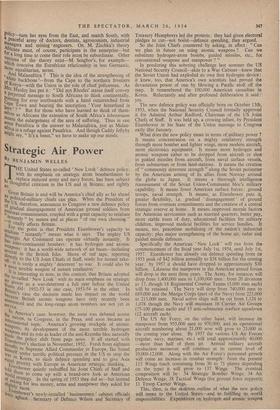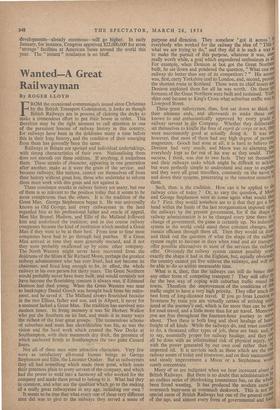Strategic Air. Powers
43' BENJAMIN WELLES THE United States so-called ' New Look ' defence policy, with its emphasis on strategic atom bombardment to loreplace reduced army and navy forces, has been subject so, thoughtful criticism in the US and in Britain; and rightly Great Britain is and will be America's chief ally as far ahead as Political-military chiefs can plan. When the President of the US, therefore, announces to Congress a new defence policy 0, 0, gradual disengagement of American ground soldiers from overseas commitments, coupled with a great capacity to retaliate Instantly " by means and at places ' of our own choosing " --it vitally affects Britain. , re Per the point is that Presideht Eisenhower's capacity to ..taliate " instantly " means what it says. The mighty US .trategie Air Command can operate virtually instantly. It nwas inter-continental bombers : it has hydrogen and atomic seeaP°Iis: it has a world-wide network of air bases—including d.vera,1 in the British Isles. Shorn of red tape, reporting ofifreet,IY to the US Joint Chiefs of Staff, ready for instant take- a —It is verily a mighty ' deterrent' to war. It could also be Tost terrible weapon of instant retaliation: th it is interesting to note, in this context, that Britain adopted air 813"ett Iled ' New Look ' with its main emphasis on strategic States Power as a war-deterrent a full year before the United t_a.tes did : 1952-53 in one case, 1953-54 in the other. In b_ritains case the decision made less impact on the world ti;e1C-a Use British atomic .veapons have only recently been Service. and the long-range atom bombers are not yet in .erviee. In America's the ca's case, however, the issue was debated across ,„nation, in Congress, in the Press, and soon became an int na we'arnational topic. America's ,growing stockpile of atomic Weapons, its development of the more terrible hydrogen `flia,13°ns and its role as leader of the anti-Kremlin bloc naturally ttsue the policy shift front page news. It all started with to,senhower's election in November, 1952. Fresh from eighteen hirhs as Supreme Allied Commander in Europe, Ike found Warself under terrific political pressure in the US to stop the egad° Korea, to slash defence spending and to ive Asia til, priority with Europe in American strategic thinking., told ste,nhower quietly reshuffled his Joint Chiefs of Staff and vuorldwelin to come up with a brand-new look at American Of Z.: strategy. In the spring of 1953 they did so—but instead sii,,L.'`Ing for less money, arms and manpower they asked for alight more. Treasury Humphreys led the protests : they had given electoral pledges to cut—not boost—defence spending, they argued.
So the Joint Chiefs countered by asking, in effect : Can we plan in future on using atomic weapons ? Can wo substitute hydrogen-atom bombs, guided missiles, etc., for conventional weapons and manpower ? "
In pondering this sobering challenge last summer the US National Security Council—akin to a War Cabinet—knew that the Soviet Union had exploded its own first hydrogen device: it knew, too, that America's own scientists had proved the devastation power of one by blowing a Pacific atoll off the map.. It remembered the 100,000 American casualties in Korea. Reluctantly and after profound deliberation it said : yes.
The new defence policy was officially born on October 13th, 1953, when the National Security Council formally approved it for Admiral Arthur Radford, Chairman of the US Joint Chiefs of Staff. It was held up, a crowing infant, by President Eisenhower in his State of the Union message to Congress early, this January.
What does the new policy mean in terms of military power ? It means concentration on a mighty retaliatory strength through more bomber and fighter wings, more modern aircraft, more electronics equipment. It means more hydrogen and atomic weapons either to be dropped from aircraft or shot in guided missiles from aircraft, from naval surface vessels, from submarines or from land-stations. It means the creation of " community deterrent strength " along the Soviet perimeter by the American arming of its allies from Norway around the globe to Japan. It means a thorough intelligence reassessment of the Soviet Union-Communist bloc's military capability. It means fewer American surface forces : ground troops, naval strength. It means, as Eisenhower puts it, greater flexibility, i.e. gradual ' disengagement' of ground forces from overseas commitments and the creation of a central strategic reserve at home. It means improved morale factors for American servicemen such as married quarters, better pay, more stable tours of duty, educational facilities for military children, improved medical facilities for service families. It means, too, peacetime mobilising of the nation's industrial capacity; plus major strengthening of the home air, radar and guided missile defences.
Specifically the American. ' New Look ' will run from the commencement of the fiscal year July 1st, 1954, until July 1st, 1957. Eisenhower has already cut defence spending from its 1953 peak of $42 billion annually to $38 billion for the coming year : by 1957 it should have dropped to approximately $30 billion. Likewise the manpower in the American armed forces will drop in the next three years. The Army, for instances will drop from 1,400,000 men to 1,100,000 men : from 20 divisions to 17, though 18 Regimental Combat Teams (5,000 men each) will be retained. The Navy will drop from 740,000 men to 689,000 and the Maripe Corps (part of the Navy) from 225,000 to 215,000 men. Naval active ships will be cut from 1,124 to 1,078 though the Navy will maintain 16 Carrier Air Groups (75-100 planes each) and 15 anti-submarine warfare squadrons (12 aircraft each).
The US Air Force, on the other hand, will increase its manpower from 955,000 men to 970,000; and its operational aircraft numbering about 21,000 now will grow to 23,000 in the coming year' alone. By 1957 the various US Air Forces (regular, navy, marines, etc.) will total approximately 40,000 —more than half of them jet. Annual military aircraft production moreover will continue at its current level of 10,000-12,000. Along with the Air Force's personnel growth will come an increase. in combat strength : from the present 115 Wings (each containing from 30 to 75 planes depending on the type) it will grow to 137 Wings. The eventual compogition will be : 54 Strategic Bomber Wings; 34 Air Defence Wings; 38 Tactical Wings (for ground force support); 11 Troop Carrier Wings, developments—already enormous—will go higher. In early January, for instance, Congress approved $22,000,000 for atom `storage' facilities at American bases around the world this year. The " instant " retaliation is no bluff.











































 Previous page
Previous page